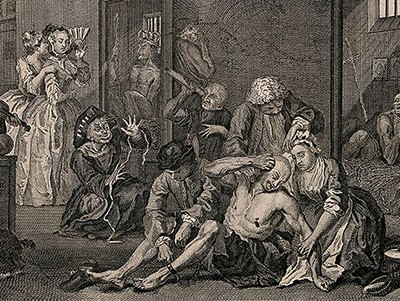Trust The Science™
Nature: When scientists gave 1,000 vulnerable people hepatitis over 30 years
What sort of system nurtures a decades-long programme of deliberately infecting children and prisoners with a dangerous disease?
In 1942, in the grip of the Second World War, the US military faced an existential threat from within. A hepatitis outbreak was suspected to have infected hundreds of thousands of personnel.
There were no animal or cell-culture models for studying the viral liver disease. Desperate to find the source of the outbreak and learn how to contain it, the military joined forces with biomedical researchers, including some from the University of Pennsylvania in Philadelphia and Yale University in New Haven, Connecticut, to launch human experiments that continued for decades after the war.
During the 30-year programme — meticulously chronicled in Dangerous Medicine — researchers infected more than 1,000 people, including over 150 children, with viruses that cause hepatitis. The people enrolled were prison inmates, disabled children, people with severe mental illnesses, and conscientious objectors performing community service in lieu of fighting, relates historical sociologist Sydney Halpern. Owing to biases in the US prison and psychiatric-hospital populations, a disproportionate number were Black. The long-term consequences will never be fully reckoned: although rarely fatal in the short term, hepatitis can lead to chronic liver disease and cancer years after the initial infection.
These days, horrifying stories of human medical experiments in the mid-twentieth century are well-trodden territory, the most famous being the studies in Tuskegee, Alabama, that withheld treatment from hundreds of Black men with syphilis for decades, starting in the 1930s. “Research abuse narratives are embedded in our collective memory,” Halpern writes. “They serve to affirm the moral priorities we proudly hold.”
But Dangerous Medicine does more than add another gruesome narrative to the canon. It offers a thorough exploration of the social, military and scientific context that nurtured what would now be considered repugnant and unethical medical conduct. By avoiding a simple story of a single rogue investigator or team and instead focusing on the system that gave rise to abuse, Halpern amplifies the narrative that she has painstakingly pieced together from hundreds of historical documents.
System failure
The hepatitis experiments began in 1942 with the outbreak of the disease among US soldiers and military personnel, which was, researchers eventually determined, caused by a contaminated batch of yellow fever vaccine. Launched under the aegis of the war effort, the studies ended only in 1972, when public and professional sentiment towards experiments on vulnerable populations shifted.
Researchers studied a wide range of hepatitis biology, distinguishing between hepatitis A, which is transmitted by contaminated food, and hepatitis B, often spread by contaminated blood products. They looked for ways to inactivate the hepatitis B virus in blood supplies, and tested treatments and means of prevention.
Some of the studies involved deliberately exposing people to infected material, either by injection or through ingestion of “milkshakes” containing hepatitis virus in the form of stool samples mixed with chocolate milk. At least four people died from the disease in the course of these experiments. But with no long-term follow-up — monitoring stopped when the individual experiments ended — there are no data on how many became disabled or died years later as a result of their infection.
A 1945 newsletter for the Civilian Public Service camp in New Haven, Connecticut, where conscientious objectors were enrolled in hepatitis studies as part of the war effort.Credit: David Hileman Miller/Swarthmore College Peace Collection
For decades, the researchers justified their work to colleagues and the press, reframing it to meet the ethos of the times. Initially, it was portrayed as a necessary sacrifice to support the troops. Later, experiments on people in prison were pitched as paths to rehabilitation through service to society. Studies on mentally ill people were an extension of ‘fever therapy’ — the idea among some scientists at the time that high body temperature caused by infectious diseases such as malaria and, perhaps, hepatitis might improve some psychiatric conditions. And experiments on disabled children were rationalized as an attempt to generate immunity against a disease that was already frequent in the crowded and unhygienic institution in which they were housed.
Notwithstanding her attention to context, Halpern does not let individuals off the hook. Some study leaders knew how their work might horrify the public, and tried to control how they were portrayed in the press — first suppressing coverage, and later encouraging narratives that painted participants as heroes. Some journal editors not only published scientific findings from the hepatitis experiments, but also wrote editorials praising the work.
And, Halpern points out, although the long-term consequences of hepatitis were not fully understood at the time of the experiments, there were signs as early as the 1940s, and the researchers could have acknowledged them. Eventually, by the 1970s and 1980s, epidemiological studies had shown that carriers of hepatitis B were more likely to develop cirrhosis and liver cancer than those who were not carriers.
Particularly crushing is the naivety about how hepatitis affects children. The immediate symptoms are not as severe in children, so scientists argued that infecting young people would give them immunity that would protect them when they grew older and more vulnerable to severe infections. In fact, children with hepatitis B are much more likely than infected adults to become lifelong carriers, and to experience long-term consequences.
Haunting reminder
There was a time when we could have casually looked down our noses at mid-twentieth-century ignorance about infectious diseases. But with the world still in the throes of a coronavirus pandemic, I was struck by the parallels. Witness how efforts have been focused on the acute impacts of disease (hospitalization, death) without much thought to long-term consequences (disability). Or think of how those with the least agency — children, people in prison, people with severe mental illnesses — have been put at risk by those with the most power.
Formally, our approach to medical ethics has improved since the 1940s, but Halpern reminds us that many clinical trials in healthy individuals still rely on vulnerable populations. Some people move from one to the next in search of food, housing or remuneration in exchange for their participation. People in regions with poor access to health care sometimes have to enrol to get basic medical treatment. And in the United States, there is still no requirement to provide compensation for long-term disability that might arise from participation in clinical trials.
Halpern has created a haunting narrative that forces the reader to confront our modern social and scientific frame of reference. Long after the book is finished, the question remains: what research abuses are we justifying to ourselves today?



